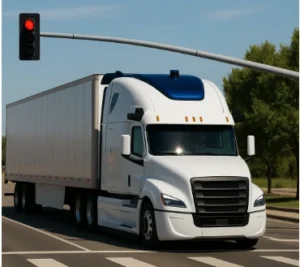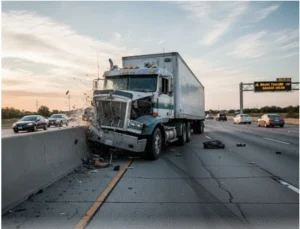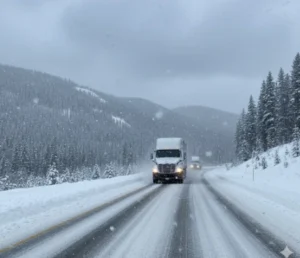As of today, April 1, the new Out-of-Service Criteria of the North American Standard 2025 from the CVSA come into effect.
As of today, April 1, the new Out-of-Service Criteria of the North American Standard 2025 from the Commercial Vehicle Safety Alliance (CVSA) come into effect. These criteria replace all previous versions, making it crucial for both truck drivers and carriers to stay informed about the changes.
The aim of these regulations is to determine whether drivers or vehicles pose an imminent danger, which could result in them being put out of service. CVSA has implemented these regulations to ensure that professional drivers operating on North American roads are safe and comply with the established standards.
The Out-of-Service Criteria are updated annually and go into effect on April 1 each year. Below, you will find the changes made, categorized according to a recent article from FreightWaves Playbook.

Out-of-Service Drivers: Medical Certification and Bans
1. Out-of-service drivers cannot accompany CLP holders
The CVSA’s new updates clarify that a CDL holder with a suspension, disqualification, or violation in the Federal Motor Carrier Safety Administration’s Drug and Alcohol Clearinghouse cannot act as an accompanying driver for a CLP holder in training. This means that CDL holders with unresolved alcohol or drug violations cannot serve as instructors.
2. Drivers without a medical certificate
It will be mandatory for all drivers to have a valid medical card issued by the Department of Transportation (DOT). If a driver does not have this card, they will be immediately put out of service. Previously, there were distinctions based on the type of load or vehicle operated, but with this update, driving without a medical card—whether due to lack of one or expiration—is not allowed under any circumstances. Therefore, it is important to:
- Ensure your medical card is valid and keep track of expiration dates.
- Maintain both digital and physical copies of your medical card.
- Set calendar reminders to renew your medical certificate before the deadline.

Out-of-Service Vehicle Updates
1. Brake System
The new regulation introduces a general violation for inoperative brakes caused by disconnected electrical cables or uncoupled service hands. Previously, DOT inspectors documented each inoperative brake separately, but now a single unplugged cable or disconnected hand can result in an out-of-service order. It is recommended to:
- Check the electrical cables and hands before each trip.
- Ensure all connections are secure.
2. Air Hoses and Lines
The previous rule that considered coupled air hoses an automatic out-of-service violation has been removed. Instead, inspectors will recognize that wavy hoses affect brake release more than brake application. However, this should not be seen as an exemption, as if the braking function is compromised in any way, your truck can still be put out of service.
3. Tire Regulations
Tires will be one of the main focuses of 2025 inspections, so CVSA has introduced several key updates:
- If a tire has a noticeable leak in the tread area and lacks an automatic tire inflation system (ATIS), it will be put out of service.
- Any tire with a leak in the sidewall will also be automatically out of service, regardless of whether it has an inflation system.
- Out-of-service conditions for radial and bias tires have been unified into a single rule.
- If only the rubber of a fender touches a tire, it is not considered a violation.
4. Suspension Enforcement
CVSA has provided new diagrams to help inspectors correctly identify suspension bolts and bushings, reducing identification errors. It is recommended to regularly inspect U-bolts and lower plates as part of preventive maintenance. Additionally, if your truck has old suspension components, consider upgrading them.

How to Prepare for These Changes?
Keeping your vehicles and documents up-to-date and in optimal condition is essential to adapting to these changes. Consider obtaining the CVSA Out-of-Service Manual, where you can find more information about the new regulations and how to avoid violations.

USDOT Withholds $40 Million from California Over English Proficiency “Rule Rebellion”
The U.S. Department of Transportation (USDOT) has announced that it will withhold more than $40 million in federal highway safety funds from California for failing to enforce national English Language Proficiency (ELP) standards for commercial truck drivers.

ICE operation detains 120 drivers along the I-40
A three-day ICE operation along the I-40 led to the detention of 120 drivers for immigration-related violations. A three-day operation along Interstate 40 in western

October’s bankruptcy spike: 5 carriers file for Chapter 11 in just two weeks
During the first half of October five transportation-related companies filed for bankruptcy under Chapter 11. The transportation industry has gone through difficult months, but October

Could It Happen with Trucks? Tesla Investigation Reopens the Debate on Autonomous Freight Safety
Could It Happen with Trucks? Tesla Investigation Reopens the Debate on Autonomous Freight Safety

Road Safety in the U.S.: Faulty Brakes and Slow Tech Adoption Still Cause Thousands of Truck Crashes Every Year
Road Safety in the U.S.: Faulty Brakes and Slow Tech Adoption Still Cause Thousands of Truck Crashes Every Year

U.S. Trucking Companies Prepare for the Winter Season: Maintenance, Safety, and Efficiency
As winter approaches across the United States, trucking companies strengthen their maintenance, safety, and efficiency protocols to ensure uninterrupted freight movement. Preparing for harsh weather is essential for drivers, fleets, and logistics operators to maintain performance and protect both cargo and personnel.
